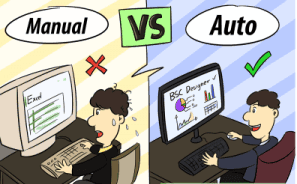How to Improve Your Inspection Workflows
Inspections are an inevitable part of life in enterprises for quality checks and compliance purposes. Such inspections, though unavoidable divert resources and distract focus from the core business activity, as such, is seen as a drag on resources.
However, a smooth and streamlined inspection workflow, integrated to core business processes can minimize the disruption and actually leverage the inspection process for the benefit of the enterprise.
Here are five ways to streamline inspection workflows for the New Year
1. Have Clarity of Purpose
Have clarity of purpose, and understand the exact deliverable required out of the inspection workflow. For instance, if the inspection is carried out as part of legal compliance, make sure the workflow captures all the required information necessary to populate the reports, and the process flow complies with the requirements of the regulations. If the objective is adherence to quality standards, keep the end in mind, and plan on how the workflow will track the required statistics.
Big is not always beautiful. Resist the temptation to introduce wholesale or big changes, just for the sake of it. More often than not, small incremental tweaks made at the right place can deliver huge improvements.
2. Treat Documentation Seriously
Strange as it sounds, at times even the best-oiled enterprise may overlook the obvious. Documenting or defining processes is one such instance of the often overlooked obvious. Documenting the inspection workflow lends clarity and order to the process. It also makes explicit complex, convoluted, or roundabout processes that can be eliminated or bypassed.
While there is a need to make the documentation as exhaustive or thorough as possible, to capture all processes, there is also a need to keep it simple. Infusing the documentation with illustration and flow charts serves the purpose, and makes it doubly easy to identify complexities, and make amends.
Break down the process into discrete steps, with more granular the process the better. Also, rank each process in order of importance, giving priority to streamlining processes that actually matter, or are the most critical. Many processes are interdependent, and as such streamlining such processes may be best effected together with such interconnected process, for greater effectiveness.
3. Value Progress over Perfection
Many managers fall into the trap of perfection. No workflow is perfect, and even the best-laid plans falter in the face of practical exigencies. Aim for progress, or getting the work done in the fastest possible time, with minimal effort and resource, rather than artistic perfection. The caveat is to ensure no process mandated by regulatory or compliance requirement are skipped or bypassed in the quest for speed or efficiency.
In any case, contemporary business is extremely fluid, where workflows need to change rapidly, to cater to the evolving requirements. Trying to cope with the requirements of an ever-changing infrastructure with stagnant workflows and technologies would be like trying to compete in a drag race with a jalopy.
For greater effectiveness and accurate results, match the changes in business processes, brought about by technology, with changes in workflow inspection methodologies. A case in point: IoT may enable turning lighting systems on and off automatically, depending on the time of the day, sensors detecting movement of people, and other considerations, An inspection schedule that offers a checklist involving switching on and off the light at set times becomes counterproductive and disruptive.
4. Invest in Collaborative Workflows
The world is increasingly becoming collaborative. No initiative to streamline processes works without involving the key stakeholders in the mix. With regards to inspection workflows, the field staff, or employees who actually conduct the inspection would know better than anyone else how to improve the process, how to enhance it, and how to remove roadblocks. Such stakeholders may have suggestions for even trying something radically new to achieve the same thing.
Make the process collaborative, and involve the field staff to buy their support for the initiative. Failure to do so will invariably result in a disconnect, with the manager sitting in the cabin, looking at flowcharts and powerpoint presentations, deciding on what would make the process efficient, when the actual situation on the ground may be completely different.
5. Automate the Process
Many businesses, in fact about 70% to 80% of them, still use spreadsheets to manage their workflows. Spreadsheets offer convenience, but are error-prone, require lots of manual work, and can create serious versioning clashes. It makes sense to invest in modern field inspection software that automates the process, to improve accuracy, reduce manual entries, and speed up the process. Such inspection suites capture key information automatically, leveraging the camera, bar-code scanner and other features available in the smartphone, populate fields seeking duplicate or derived information automatically, auto generate reports, and issue automated alerts as required. Intuitive workflow inspection software makes it easy to change workflows as required by simple drag-and-drop mouse clicks, to meet the exigencies of the situation, or to reflect the changing needs of the business.
Inspections are not easy. A mobile inspection app that eliminates paperwork, streamlines the workflows, and makes the process transparent goes a long way in reducing the drag, and ensure the inspection meet its realized objectives.
Stay up to date on what's new

Recommended Posts

28 Feb 2020
Jaw-dropping Facts about Robotic Process Automation
How is RPA turning into a highly sought-after technology Robotic Process Automation or RPA is one of the fastest-growing segments in the global enterprise software category. Research analyst Gartner says……

11 Jul 2017 Manufacturing
Automating Operations for your Business: Pros and Cons
The quest for improved productivity and efficiency in a highly competitive world has landed many enterprises at the altar of automation. A global survey by the Grant Thornton International Business……

11 Apr 2017
How Augmented Reality Is All Set to Transform Your Workplace
Augmented Reality is a hot emerging technology that modifies a real-world plain-sight view by superimposing a real-time computer-generated sensory image, sound, video, GPS data, or graphics, in a semantic context.……

06 Oct 2016
Working Hard? Advance your Business Process to Work Smart Instead
Business leaders, often focusing on the immediate and the more pressing, relegate internal processes to the secondary. As a result, inefficiencies of various hues creep in, over time. Inefficiencies manifest……
Featured Blogs
Stay up to date on
what's new


















 US
US Insurance
Insurance









































